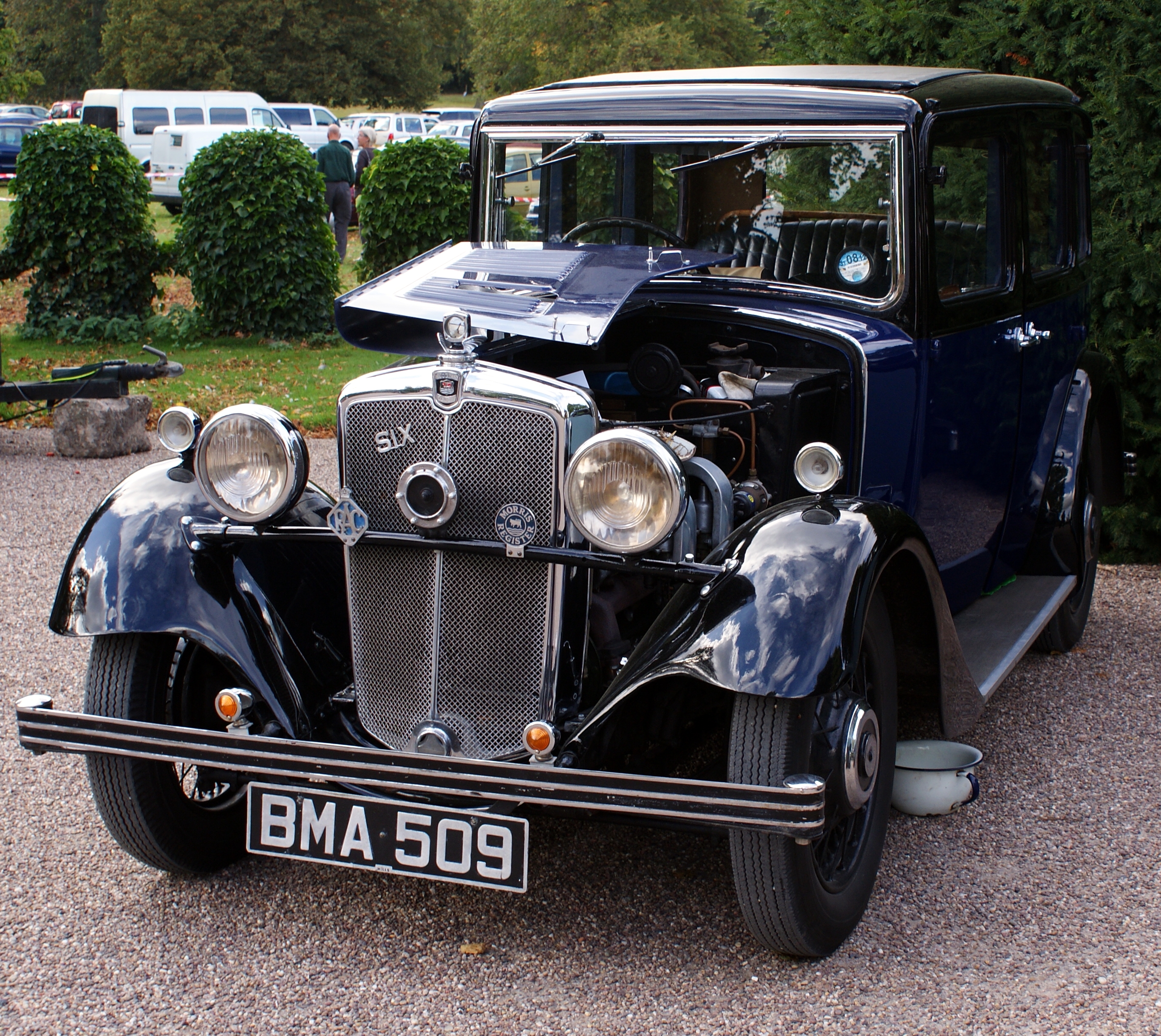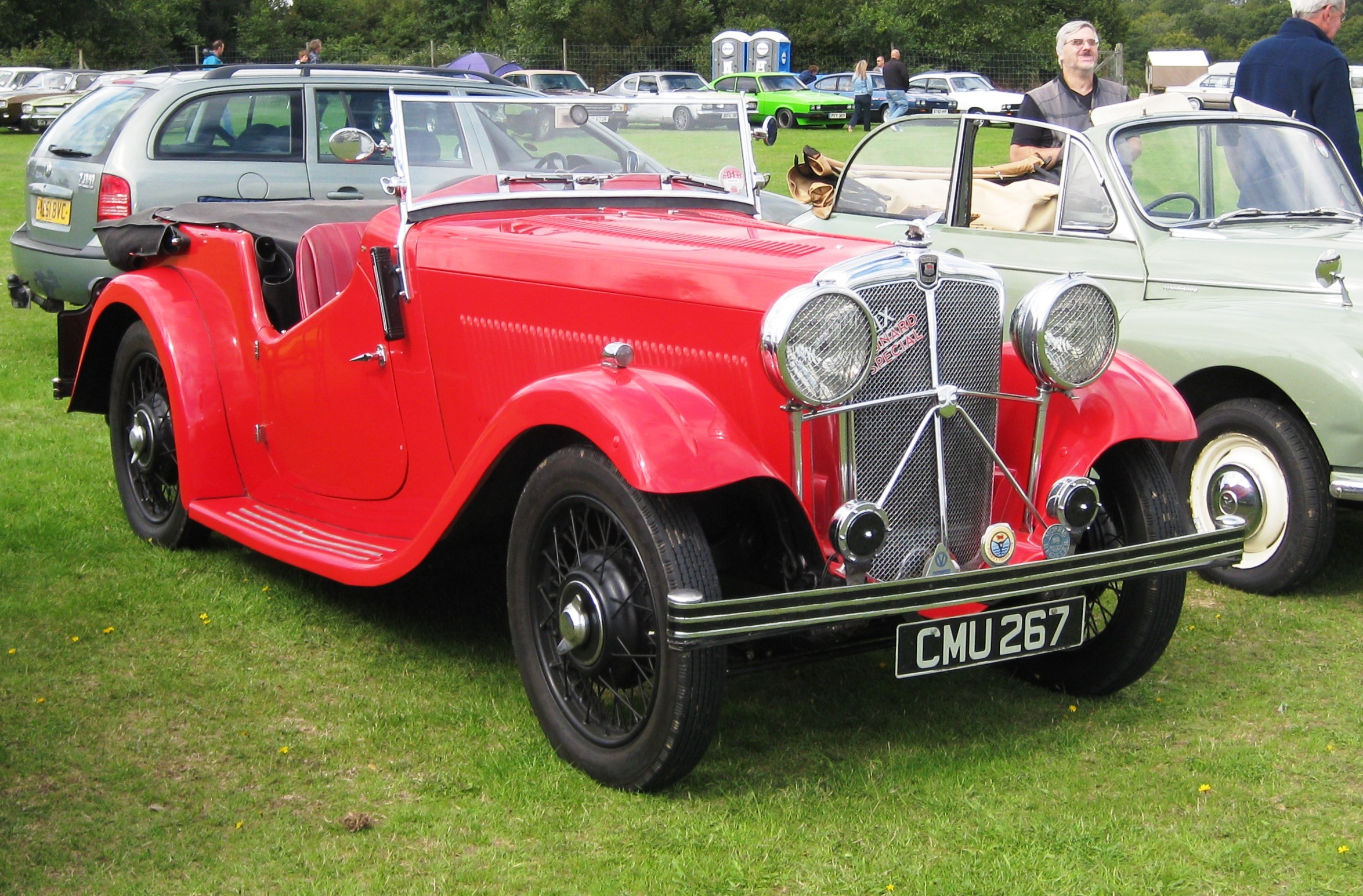Morris 10 on:
[Wikipedia]
[Google]
[Amazon]
The Morris Ten announced 1 September 1932Cars Of 1933. ''The Times'', Thursday, Sep 01, 1932; pg. 7; Issue 46227. (907 words) is a medium-sized car introduced for 1933 as the company's offering in the important 10 hp sector of the British market. It continued through a series of variants until October 1948 when along with Morris's Twelve and Fourteen it was replaced by the 13.5 hp


Morris-ten-four-radiator-detaill.JPG, Ten Four badge
MHV Morris 10-4 special coupe 1934.jpg, Ten Four Special coupé
with sliding head Jour d'la Libéthâtion Jèrri 9 d'Mai 2010 54.jpg, Open two-seater
with dickey Morris 10-4 1934 (9064980039).jpg, Closed dickey seat MHV Morris 10-4 02.jpg, Ten Four with luggage
on the fold-down rack
Twelve months later, with the introduction of the Ten Six, Four was added to the Ten's name. The chassis was strengthened, engine mountings were revised and synchromesh appeared on the gearbox. Engine output was increased to 27½ bhp by April 1934. Two tone paint schemes were optional from 1935.
 : Prices
* Special coupé £215
* Traveller's saloon £200
* Sliding head saloon £189.10.0
* Fixed head saloon £184
* Tourer £184
* Two-seater £180
A sporting version, the Ten-Six Special was also made in small numbers with tuned engine and twin
: Prices
* Special coupé £215
* Traveller's saloon £200
* Sliding head saloon £189.10.0
* Fixed head saloon £184
* Tourer £184
* Two-seater £180
A sporting version, the Ten-Six Special was also made in small numbers with tuned engine and twin 
Morris Ten-Six August 1935 radiator badge.JPG
Morris Ten Six Special (1934), Dutch licence registration DE-76-11 pic1.JPG, Special sports
as shown at Olympia Morris Ten Six Special (1934), Dutch licence registration DE-76-11 pic7.JPG

Morris Ten Series "M" Workshop Manual, www.ebay.ie as archived at web.archive.org
/ref> was introduced in 1938. It was a completely new car with unitary construction, although the styling was little-changed from the outgoing Series E. The engine was also new, being the 1140cc X-Series with an output of at 4600 rpm. Although an
File:Morris_Ten_Series_M_head.jpg, Pre-war Ten Series M
File:1946.morris.ten.series.m.arp.jpg, Postwar car with new grille
Morris Ten Four Morris Ten Six 1934
Morris Ten Four series III
Morris Ten series M
{dead link, date=February 2018 , bot=InternetArchiveBot , fix-attempted=yes
The Morris Register
The Morris Register of Victoria (Australia)
Morris Register of New Zealand Inc
Ten Cars introduced in 1933 1940s cars
Morris Oxford MO
Morris Oxford Series MO is an automobile produced by Morris Motors of the United Kingdom from 1948 to 1954. It was one of several models to carry the Morris Oxford name between 1913 and 1971.
__TOC__
Saloon
After the Second World War the 13.5 ...
.
__TOC__
Morris Ten and Ten Four
Morris Ten was a new class of car for Morris now equipped with wire wheels and a new type of mud guarding—domed wings with wing side shields—it was powered by a Morris 1292 cc four-cylinder side-valve engine employing a singleSU carburettor
SU carburettors were a British manufacturer of constant-depression carburettors. Their designs were in mass production during most of the twentieth century.
The S.U. Carburetter Company Limited also manufactured dual-choke updraught carburetto ...
which produced 24 bhp at 3,200 rpm. The gearbox was a four-speed manual transmission
A manual transmission (MT), also known as manual gearbox, standard transmission (in Canada, the United Kingdom, and the United States), or stick shift (in the United States), is a multi-speed motor vehicle transmission system, where gear change ...
unit, behind a wet cork clutch and Lockheed hydraulic brakes were fitted to 19 inch wheels. Early models had a centre accelerator pedal and large sidelamps on the wings, the propeller shaft had Cardan (Rag joint) disc couplings made from leather. After 1933 wheels became 18 inch and the accelerator pedal was moved to the right of the cluster to become the modern convention.
The October 1932 Olympia Motor Show introductory prices:
* chassis £127.10.0
* coach-built saloon with sliding head £169.10.0
* special coupé with sliding head £195.0.0
Body styles at launch in August 1932 were restricted to a saloon and two-door coupé, but a four-door tourer joined the range in December, followed in 1934 by a two-seater with dickey seat
A rumble seat (American English), dicky (dickie/dickey) seat (British English), also called a mother-in-law seat, is an upholstered exterior seat which folded into the rear of a coach, carriage, or early motorcar. Depending on its configuration ...
and a Traveller's Saloon.


Ten Four
with sliding head Jour d'la Libéthâtion Jèrri 9 d'Mai 2010 54.jpg, Open two-seater
with dickey Morris 10-4 1934 (9064980039).jpg, Closed dickey seat MHV Morris 10-4 02.jpg, Ten Four with luggage
on the fold-down rack
Morris Ten Six
On 28 August 1933 a 12 hpsix-cylinder
The straight-six engine (also referred to as an inline-six engine; abbreviated I6 or L6) is a piston engine with six cylinders arranged in a straight line along the crankshaft. A straight-six engine has perfect primary and secondary engine balan ...
version of the Ten was announced on the longer-wheelbase chassis of the Cowley Four.Cars Of 1934. ''The Times'', Monday, Aug 28, 1933; pg. 6; Issue 46534.
 : Prices
* Special coupé £215
* Traveller's saloon £200
* Sliding head saloon £189.10.0
* Fixed head saloon £184
* Tourer £184
* Two-seater £180
A sporting version, the Ten-Six Special was also made in small numbers with tuned engine and twin
: Prices
* Special coupé £215
* Traveller's saloon £200
* Sliding head saloon £189.10.0
* Fixed head saloon £184
* Tourer £184
* Two-seater £180
A sporting version, the Ten-Six Special was also made in small numbers with tuned engine and twin SU carburettor
SU carburettors were a British manufacturer of constant-depression carburettors. Their designs were in mass production during most of the twentieth century.
The S.U. Carburetter Company Limited also manufactured dual-choke updraught carburetto ...
s. the standard body was an open four-seater, but some chassis were supplied to coachbuilders.
Ten Six Special sports
The Morris Ten Six Special sports displayed at Olympia in October 1933 had a long bonnet with a strap, louvred valances by the frame without running boards, low-sloping or cutaway doors, and a flared back with a low tail. Its chassis was as the Ten Six with twin carburettors, a special radiator with stone-guard, spring steering wheel, special speedometer and revolution indicator, remote gearbox control, two horns, an electric petrol pump and automatic ignition advance.The Olympia Show. ''The Times'', Saturday, Oct 14, 1933; pg. 7; Issue 46575as shown at Olympia Morris Ten Six Special (1934), Dutch licence registration DE-76-11 pic7.JPG
Morris Ten series II
A rationalisation of the Morris range took place in 1935 and the new Ten series II shared its body and chassis with the Morris Twelve series II. A three-speedmanual gearbox
A manual transmission (MT), also known as manual gearbox, standard transmission (in Canada, the United Kingdom, and the United States), or stick shift (in the United States), is a multi-speed motor vehicle transmission system, where gear change ...
was fitted at first, but a four-speed reappeared as an option from 1936 and standard from 1937. Steel disc Easiclene wheels replaced the wire ones at the end of 1936. Two tone paintwork is common.
Morris Ten series III
For 1938 the engine was updated to overhead valve as fitted to theWolseley Ten
The Wolseley Ten is a light car which was produced by Wolseley Motors Limited in 1939 and from 1945 to 1948 .
The ten horsepower class of cars was an important part of the market in 1930s Britain and Wolseley entered the sector with their 10/4 ...
increasing the power output from 27 to 37.5 bhp. The chromium-plated radiator surround was replaced by a painted one, and all paint schemes were single, rather than two-tone.
Morris Ten Series M
The Morris Ten Series M/ref> was introduced in 1938. It was a completely new car with unitary construction, although the styling was little-changed from the outgoing Series E. The engine was also new, being the 1140cc X-Series with an output of at 4600 rpm. Although an
overhead valve engine
An overhead valve (OHV) engine, sometimes called a ''pushrod engine'', is a piston engine whose valves are located in the cylinder head above the combustion chamber. This contrasts with earlier flathead engines, where the valves were located b ...
like the M-Series engine fitted to the previous Ten Series E, the X-Series was a brand new design following the disappointing performance and reliability of M-Series, which was related to the older Morris sidevalve
A flathead engine, also known as a sidevalve engine''American Rodder'', 6/94, pp.45 & 93. or valve-in-block engine is an internal combustion engine with its poppet valves contained within the engine block, instead of in the cylinder head, as ...
engines. The Series M's X-Series engine had a 'free-flow' eight-port cylinder head and adopted features from contemporary American engines including a pressurised pump-driven cooling system, a fully filtered lubrication system and an automatic tensioner for the camshaft chain. Along with the contemporary Vauxhall 10-4
The Vauxhall 10-4 is a British-built small family car produced by Vauxhall between 1937 and 1947. It was launched at the October 1937 London Motor Show and was the first British car to have a unitary construction body. The first car was deliver ...
the Series M was one of the first mass-market British cars to feature an OHV engine and the Morris was praised for the smoothness, efficiency and quiet-running of its engine. The car had a top speed of around . The running gear was otherwise very conventional, even old-fashioned, for the time, with solid axles with longitudinal leaf spring
A leaf spring is a simple form of spring commonly used for the suspension in wheeled vehicles. Originally called a ''laminated'' or ''carriage spring'', and sometimes referred to as a semi-elliptical spring, elliptical spring, or cart spring, i ...
s all-round. Plans had been drawn up to provide the unitary-construction Ten with independent front suspension
Independent suspension is any automobile suspension system that allows each wheel on the same axle to move vertically (i.e. reacting to a bump on the road) independently of the others. This is contrasted with a beam axle or deDion axle system in ...
and Rack and pinion steering, but these were shelved due to cost and marketing concerns, although the parts designed for the Series M would appear in the post-war MG Y-type
The MG Y-Type is an automobile produced by MG in England from 1947 to 1953. It was offered in four-door saloon and limited production open four-seat tourer versions.
When production ceased, 8,336 "Y" Types had been produced, 6,131 of which we ...
saloon.
Only saloon bodies with optional sun roof were made for the civilian market but a range of pick up bodies were fitted during World War II as one of among many similar products by British manufactures collectively known by the nickname "Tillies". The car was also assembled in India as the Hindustan 10 .
Postwar models can be distinguished from those made before late 1945 by a cosmetic change to the radiator grille, the later versions being rounder, faired in to the engine side panels and without the Morris badge at the top.
References
External links
;Full colour brochures:Morris Ten Four Morris Ten Six 1934
Morris Ten Four series III
Morris Ten series M
{dead link, date=February 2018 , bot=InternetArchiveBot , fix-attempted=yes
The Morris Register
The Morris Register of Victoria (Australia)
Morris Register of New Zealand Inc
Ten Cars introduced in 1933 1940s cars